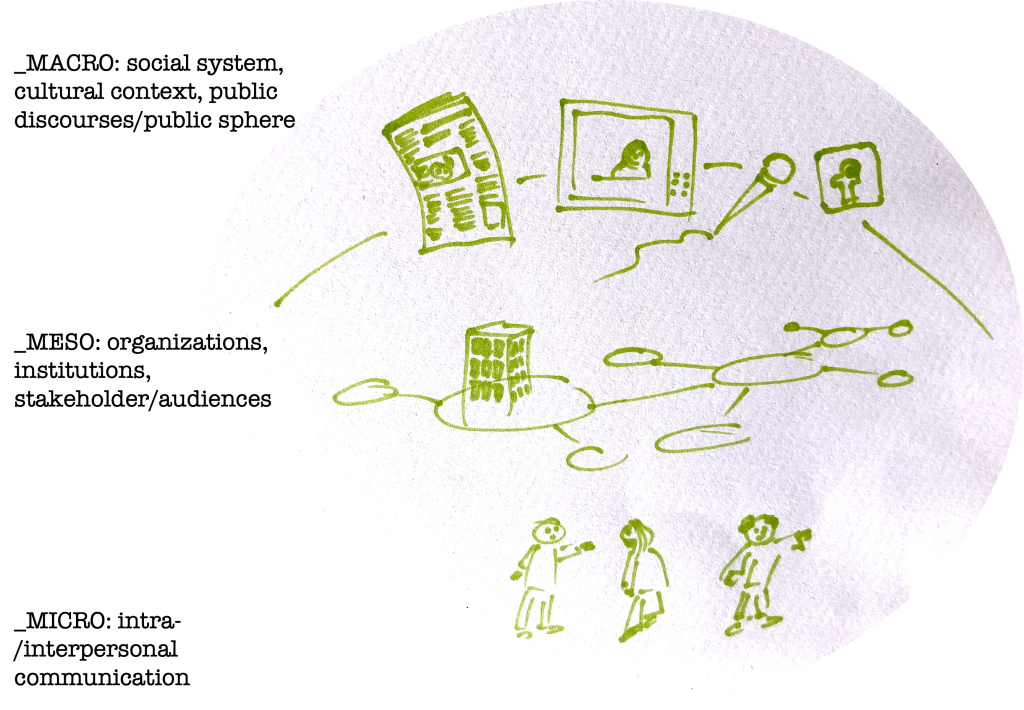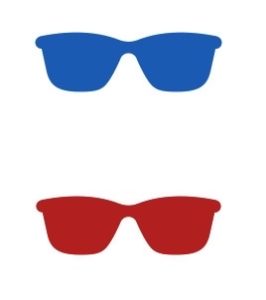II.1. Communication or communicating – perspectives on communication
Franzisca Weder
The lady…
“What about us here – what is that?” I asked the lady. We’re still here, in the middle of the road, on a hot day in the bright sunshine. Looking at each other. Talking. Asking questions, answering questions and asking new question again. Thinking and reflecting, considering and questioning. “This is what we can also call communication. But not communication in a way that I desperately want to tell you something. Or want to inform you, or educate you. This is different; this is an exchange process, or even better: a sense making process; together we create our understanding of the world – and sustainability, sustainable behavior, sustainable development in particular!”
I was thrilled – I never thought about conversations as being so … constructive, or deliberative. That they make sense – so actually help me to understand the world. Even better: with every thought, with small talk, with every interaction with other people I slightly change my understanding and my vision of this world and my own self in this world.
Sustainability as a paradigm, principle or moral compass for individual as well as organisational practices as well as narrative of the future combating the more established Climate-Change narrative, used (and sometimes abused) in mainly corporate discourses, is influenced by these meta-processes and related technological innovations – often by social media and new information technologies. Thus, communication about, of and for sustainability is influenced by these changes.
Consequently, today:
- there are many levels on which we communicate (individual/micro, organisational/meso, media/macro (see fig. below)

Figure: “MACRO, MESO, MICRO” by Franzisca Weder
- there are multiple, partly converging arenas in which we communicate (i.e. the converging political and economic discourse),
- there are various kinds of people communicating with all kinds of world views (hegemonic voices from politics on the one hand, and rather invisible NGO actors on the other hand).
But the purpose of this book is not only to study this debate, but also to contribute to it.
Sustainability studies – even without thinking about communication of, about or for sustainability here – has been characterized as having an interdisciplinary as well as transdisciplinary character (see chapter I.4). It somehow automatically opens up questions of who communicates what in which channel to whom and with what effect and impact around sustainability and the responsibility of organizations in sustainable development. Communication in related to CSR and sustainability is thus mostly approached from a rather pragmatic perspective.
A pragmatic perspective on communication…
The pragmatic understanding of communication correlates with a positivist worldview; its origin lies in the age of mass communication – however, since alternatives to mass distribution (and alternatives to related concepts like propaganda, mass political campaigning etc.) first emerged in the 1960s (Enzensberger, 1970), new concepts have evolved, superseding the one-directional flow of communication with certain functions and effects, interpreted as transmission process, which is manifested in the models of Shannon and Weaver (1949) with the “formula” of who (sender/communicator), says what (content) to whom (receiver/audience) in which channel (media) with what effect (see Introduction) (see this chapter).
The concept of communication behind that is that a sender or source of information selects a topic or idea or even makes an issue out of an event or object; it is then created as content containing a certain message, which is encoded or translated into a certain form of written words, visual or audio or even dramatization. After being sent through a channel which shapes how the message is presented, the receiver or public or audience gets the message, decodes and further interprets it based on and influenced by their own experience and context-related values and sets of norms. Increase of knowledge, awareness and even a certain change of behaviour or opinion change as result is possible – and often aimed, at least for from a strategic point of view:

Graphic: ‘Formula of communication as transmission process’ by Franzisca Weder.
However, while most of CSR, sustainability and strategic communication research in general uses this rather linear concept of communication as a (transmission) process, and thus a rather pragmatic, which means functional and instrumental understanding of communication, there is a different perspective on communication that we need to understand. This goes back to the paradigm of social-constructivism and offers us a rather critical, constructivist perspective on communication. From this perspective, everything that we do as human being is somehow communication, or in other words, we cannot not communicate. From this perspective, communication is an ongoing sense and meaning making process of the world. Therefore, there is not ‘one reality’ that can be described; instead, reality or what we perceive as such is created in interactions and through conversations between individuals or within groups.
We will now play around with these different perspectives, play around with different communicator roles, observe communication processes from both; a rather pragmatic on the one hand and a rather constructivist, ritual perspective on the other hand. So, let’s get more “hands on”:
For a better understanding and a ‘clearer view’ on the two paradigms that we use to understand communication structures and processes in our society, please copy the doodle(d)-glasses onto a piece of scrap paper; or draw two pair of glasses and colour them blue and red and cut them out!

Images by Franzisca Weder
We will use the two pairs of glasses to look at certain examples of CSR and sustainability communication from both a pragmatic (structural, functional) and a critical (constitutive, social constructivist) perspective, as they will appear in this book from time to time.
Before we actually start with the examples and the application, we need to understand why we use ‘glasses’ to give you a more tangible idea of what paradigms are. A paradigm like the two main paradigms in sociology (pragmatic, functionalist or institutional on the one hand and critical, social constructivist on the other hand) goes beyond the idea of “grand theories”. A paradigm is a certain lens and thus basic understanding used to approach and look at a certain problem, or in Thomas Kuhn’s words, a set of “model problems and solutions for a community of researchers” (Kuhn, 1970/1962, p. viii). In other words: a paradigm is a set of puzzles and a coherent or at least corresponding set of agreed upon methodologies for trying to solve these puzzles.
Again, on the one hand, there is the pragmatic, functional understanding of communication, that describes communication as transmission process of a certain message from one system to another. The focus here is on communication structures. The other paradigm is to focus on action and communication processes that “keep these structures alive”, that produce and reproduce them. Thus, as already described above, the two possibilities to approach and interpret communication are the pragmatic, functionalist perspective and a constitutive, social constructive perspective:
Paradigms
- Pragmatic (information, education, instrumental sense of communication, functionalist/structural perspective, desription of reality)
- Constitutive (symbolic action, social constructivism, sense making,define sth as problem, creates attention, evokes values, orientation,activates/stimulates engagement, exploration)
The more structure-oriented perspective on the one hand, follows a social sciences paradigm that ranges from systems theory, (neo)institutionalism or cognitive approaches at the intersection to psychology and linguistics. The rather process-related and action-oriented perspective on the other hand, following a humanistic paradigm of explorative, critical and problematizing approach to reality.
Watch What is communication? (YouTube, 5m30s) to deepen your knowledge on the paradigms of communication:
In the next chapter, we will explore how these paradigms play out in existing concepts of strategic communication, followed by the applications in CSR and sustainability communication.

